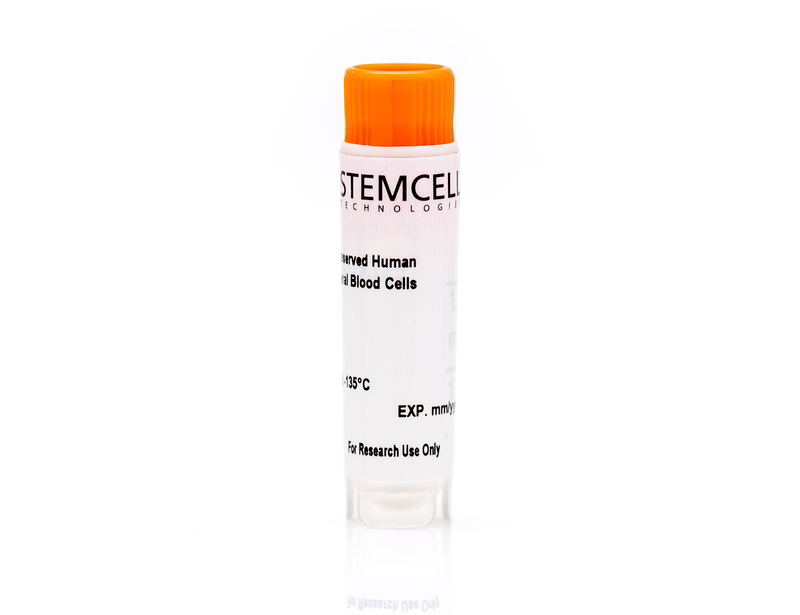概要
Primary human CD34+ cells were isolated from peripheral blood (PB) mononuclear cells (MNCs) using positive immunomagnetic separation techniques. PB was collected using acid-citrate-dextrose solution A (ACDA) as the anticoagulant. CD34 is expressed on hematopoietic stem and progenitor cells.
Cells were obtained using Institutional Review Board (IRB)-approved consent forms and protocols.
Certain products are only available in select territories. Please contact your local Sales representative or Product & Scientific Support at techsupport@stemcell.com for further information.
Browse our Frequently Asked Questions (FAQs) on Primary Cells.
Cells were obtained using Institutional Review Board (IRB)-approved consent forms and protocols.
Certain products are only available in select territories. Please contact your local Sales representative or Product & Scientific Support at techsupport@stemcell.com for further information.
Browse our Frequently Asked Questions (FAQs) on Primary Cells.
技术资料
| Document Type | 产品名称 | Catalog # | Lot # | 语言 |
|---|---|---|---|---|
| Product Information Sheet | Human Peripheral Blood CD34+ Cells, Frozen | 70040, 70040.1, 70040.2 | All | English |
数据及文献
Publications (2)
PloS one 2014 MAY
Stimulus-selective regulation of human mast cell gene expression, degranulation and leukotriene production by fluticasone and salmeterol.
Abstract
Abstract
Despite the fact that glucocorticoids and long acting beta agonists are effective treatments for asthma, their effects on human mast cells (MC) appear to be modest. Although MC are one of the major effector cells in the underlying inflammatory reactions associated with asthma, their regulation by these drugs is not yet fully understood and, in some cases, controversial. Using a human immortalized MC line (LAD2), we studied the effects of fluticasone propionate (FP) and salmeterol (SM), on the release of early and late phase mediators. LAD2 cells were pretreated with FP (100 nM), SM (1 µM), alone and in combination, at various incubation times and subsequently stimulated with agonists substance P, C3a and IgE/anti-IgE. Degranulation was measured by the release of β-hexosaminidase. Cytokine and chemokine expression were measured using quantitative PCR, ELISA and cytometric bead array (CBA) assays. The combination of FP and SM synergistically inhibited degranulation of MC stimulated with substance P (33% inhibition compared to control, n = 3, P>05). Degranulation was inhibited by FP alone, but not SM, when MC were stimulated with C3a (48% inhibition, n = 3, P>05). As previously reported, FP and SM did not inhibit degranulation when MC were stimulated with IgE/anti-IgE. FP and SM in combination inhibited substance P-induced release of tumor necrosis factor (TNF), CCL2, and CXCL8 (98%, 99% and 92% inhibition, respectively, n = 4, P>05). Fluticasone and salmeterol synergistically inhibited mediator production by human MC stimulated with the neuropeptide substance P. This synergistic effect on mast cell signaling may be relevant to the therapeutic benefit of combination therapy in asthma.
PloS one 2013 JUL
Epo receptors are not detectable in primary human tumor tissue samples.
Abstract
Abstract
Erythropoietin (Epo) is a cytokine that binds and activates an Epo receptor (EpoR) expressed on the surface of erythroid progenitor cells to promote erythropoiesis. While early studies suggested EpoR transcripts were expressed exclusively in the erythroid compartment, low-level EpoR transcripts were detected in nonhematopoietic tissues and tumor cell lines using sensitive RT-PCR methods. However due to the widespread use of nonspecific anti-EpoR antibodies there are conflicting data on EpoR protein expression. In tumor cell lines and normal human tissues examined with a specific and sensitive monoclonal antibody to human EpoR (A82), little/no EpoR protein was detected and it was not functional. In contrast, EpoR protein was reportedly detectable in a breast tumor cell line (MCF-7) and breast cancer tissues with an anti-EpoR polyclonal antibody (M-20), and functional responses to rHuEpo were reported with MCF-7 cells. In another study, a functional response was reported with the lung tumor cell line (NCI-H838) at physiological levels of rHuEpo. However, the specificity of M-20 is in question and the absence of appropriate negative controls raise questions about possible false-positive effects. Here we show that with A82, no EpoR protein was detectable in normal human and matching cancer tissues from breast, lung, colon, ovary and skin with little/no EpoR in MCF-7 and most other breast and lung tumor cell lines. We show further that M-20 provides false positive staining with tissues and it binds to a non-EpoR protein that migrates at the same size as EpoR with MCF-7 lysates. EpoR protein was detectable with NCI-H838 cells, but no rHuEpo-induced phosphorylation of AKT, STAT3, pS6RP or STAT5 was observed suggesting the EpoR was not functional. Taken together these results raise questions about the hypothesis that most tumors express high levels of functional EpoR protein.

 网站首页
网站首页








